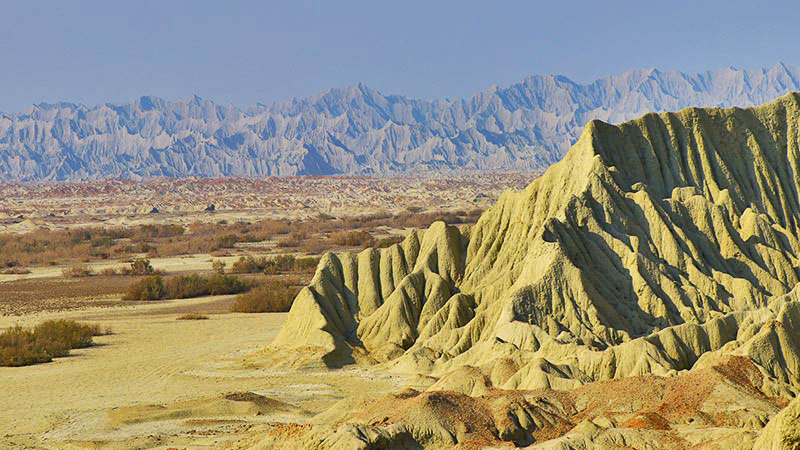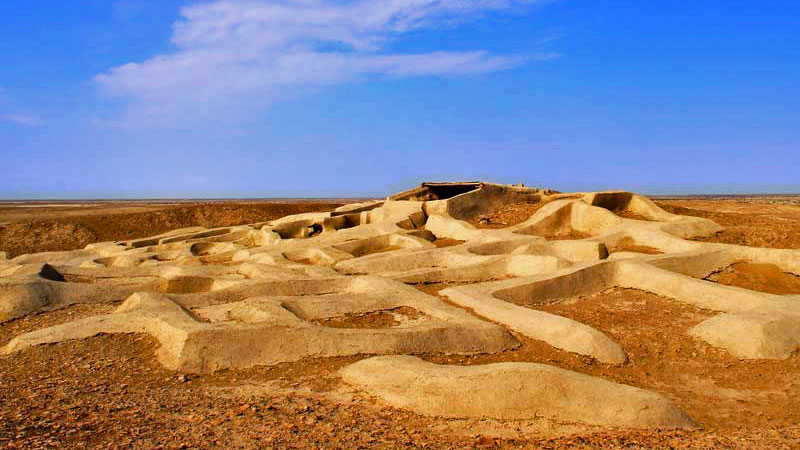 Signin with Google
Signin with Google Signin with Facebook
Signin with Facebook About Iran
About IranTop Things to Do in Sistan and Baluchistan

The southeast of Iran has long been unexplored by visitors, while it's a source of numerous natural and cultural wonders. In recent years, an increasing number of tourists have visited the province of Sistan and Balochistan, which remains a mysterious and off the beaten path destination. In the following get to know about the least known top attractions of this gem.
1. Chabahar Port, spring forever
The free-trade zone city of Chabahar locates on the coast of the Gulf of Oman. In itself, Chabahar is instead a modern city, with rooftop cafes and their view over the Gulf. Its small Bazaar in the centre gives a glimpse of the diversity of Balochi handicrafts, foods, and clothing. There is also an ancient Portuguese castle nearby, the Tis Fortress, whose brick remains dominate the sea accompanied by palm trees.

2. Darak Beach, where the world ends
A vast desert of dunes, scattered with palm trees, diving into the turquoise water of the Oman Sea. This scene is the setting of Darak Beach, one of the most beautiful beaches of Iran. The paradoxical beauty of Darak, where the wild and arid desert meets the waves of the sea, has remained pristine. The beach is next to a small village in Zarabad country of Konarak city, where you can witness Balochis authentic lives.

3. Martian Mountains, travel to Mars
Sistan and Baluchistan holds incredible natural wonders. The Martian Mountains is one of the most remarkable geological attractions of the province. Leaving Chabahar behind, along the Oman Sea on the right, the Martian badlands appears on the left side with a strange landscape.
According to geological history, these mountains date back to 4 to 5 million years ago. Fossils of fish and oysters are scattered everywhere. Wandering between these massive bizarre land formations truly creates the sense of being on another planet. Furthermore, the road leading to the mountains also has some exceptional viewpoints and passes nearby one of the handful of pink lakes of Iran called Lipar Lake. Enjoy the peace of this saltwater lake a few steps away from the tranquil beach.

4. Shahr-e Sukthe UNESCO Heritage Site
On the northern part of Sistan and Baluchistan, one of the venerable UNESCO World Heritage Sites lies under the heat and dust over 151 hectares. The ancient burnt city or Shahr-e Sukhte has more than 5000 years of history that used to be one of the largest Bronze Age sites in the Iranian Plateau. The name of the city itself holds its most preserved mystery: "Shahr-e Sukhteh" means the "Burnt City". During its long history, the site has been gutted by the flames three times.
The people of this civilisation made the first pottery productions of Iran, and archaeologists still find more potteries in excavations. The world's earliest artificial eyeball, the oldest board game, and the first drawing animation painted on a pottery vessel are among the most impressive findings of Shahr-i Sukhta.

5. Beris port, the cliff trace over Oman Sea
This small fisherman village is worth the trip 60 kilometres east from Chabahar, for its spectacular view over the harbour. In Beris, visitors can reach a cliff, from where they have a stunning panorama over the port, filled with small colourful fishermen boats and lenjs. The blue waters of the Oman Sea spread at the horizon, creating magical scenery, especially at sunset.

6. Mud Volcanos, The earth belly button
Another exceptional geothermal phenomenon in Sistan and Baluchistan is a group of mud volcanoes near the coastal line of the Oman Sea. The natural phenomenon produces eruptions of mud. Every ten to fifteen minutes, the soil vibrates, and bubbles form over the ground before the eruption itself, which looks like a small fountain. Most of the mud volcanoes are inactive, but at least one active volcano wakes up in Tang Village, near the coastal city of Konarak. These eruptions are small and, thus, not dangerous at all. On the opposite, the mud from these locations has a lot of benefits for the skin. Locals also use this mud to create pottery and traditional handicrafts.

7. Rock arts of Saravan
Sistan and Balochistan is one of humankind's cradles, and plenty of archaeological sites bear the testimony of ancient civilisations. In the valley of Saravan beautiful and well-preserved rock art is present. These carvings and paintings on the rock date back to more than 40,000 years ago. They contain figures that show the beliefs of our ancestors, with the human body, wild animals, etc. No less than 50 inscriptions have been found in the Negaran Valley, near Saravan.
8. Gandou, the only crocodile spices in Iran
From Chabahar north way to Bahu Kalat Village in Sazbaz town, lives the mugger crocodile of Iran. Baluchi people call it Gadou meaning "that which crawls on its belly". They believe this broad-snout crocodile is a sign of blessing, and they are the honorary caretaker of it. Since 1982 the marsh crocodile has been listed as vulnerable species on the red list of IUCN. According to the deputy environment chief, There is a population of some 400 muggers spotted near Bahu Kalat village and Sarbaz River. Thus the town is now on the bucket list of tourists. People come to visit the protected centre that protects Gandou.

9. Tafan Mountain, the crest of the east
Taftan is the highest mountain in south-eastern Iran, near Khash city in Sistan and Baluchistan Province. The mountain is an active stratovolcano with variable heights reported, all of them around 4,000 metres above sea level. Taftan appears to be part of a geothermal area, and several hot springs can be found around the volcano. Mountaineers climb up to the peaks of Taftan to benefit from its unique landscape over the plain lands of Baluchistan and the vegetation and climate diversity.

10. Soozan Douzi, the Baluchi renowned handicraft
The Baluchi embroidery is the most original and distinguished art of Balochi women that are globally praised. Baluch women materialise their dreams on their clothing with colourful threads and tiny mirrors. Whether in Bazaar or house workshops, get to see the way women create the masterpiece of colourful art on clothing pieces. Soozan Douzi embroidery of Baluchis is most seen through the royal dresses of Farah Diba, Iran's former empress.

11. Seb Castle
Located in the southwest of the city of Saravan, the Seb Castle is a beautifully well-preserved testimony of the Safavid Era. This 30 meters high earthen castle is one of the tallest castles of ancient Iran. It stands on a natural rocky platform and is almost intact after hundreds of years. It was built mostly of clay and mortar, on two floors.
12. Kalpuregan pottery, an alive museum
Kalpuregan is a small village in Saravan town that is a World Craft City for Handmade Pottery defined in 2020. which is the only living museum of pottery in the world. Here, local women are perpetuating a traditional art of pottery called Kapal. They have kept the same techniques and patterns for thousands of years. All materials are from the local nature and what makes Kapal pottery so recognisable is its red colour coming from the clay. Once the pottery is shaped, women draw natural and abstract patterns on it. Visitors coming to Kalpuregan have the chance to experience creating pottery themselves or observe Baluchi women preserving this traditional art.

13. Visiting the castles around Iranshahr
There are many old castles remaining in the province of Sistan and Baluchistan, especially around the city of Iranshahr. Inside this latter is the Naserie Castle, one of the largest and most essential mud castles of the region. It took seven years to achieve the construction of this vast building which has more than 150 rooms, nine watchtowers, and seven courtyards. Not far away is Bampour Castle, another exciting sightseeing. Dating back from the Sassanid and Parthian eras, it used to be the centre of the Kerman and Baluchistan governments.




